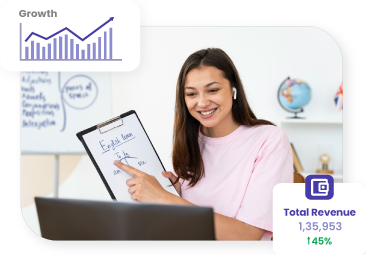You’ve invested in tools, spent hours crafting campaigns, and followed every “proven” method in the book, yet your pipeline feels more like a trickle than a flow. Leads come in sporadically; engagement feels forced, and conversions? Sounds like a distant dream.
If this resonates, you’re not alone; 45% of businesses reported struggling to generate enough leads, highlighting a significant challenge in the current marketing landscape.
2025 is here, and how prospects engage with brands has changed forever. They’re bombarded with options, skeptical of generic pitches, and armed with more information than ever before. Traditional lead generation strategies no longer cut it—they’ve become white noise in a world of endless choices.
This guide cuts through that noise, offering actionable strategies designed to help you keep up and thrive in a digital world that never stands still.
What Exactly is Lead Generation?

At its core, lead generation is turning potential prospects—individuals or organizations aligned with your ideal customer profile—into leads who express genuine interest in your offerings.
This interest often takes the form of an action, like submitting their contact details in exchange for valuable content or engaging directly with your business.
But not all leads are created equal.
Let’s explore the types of leads you should prioritize to refine your lead generation strategies and maximize results.
Types of Leads
- Marketing Qualified Lead (MQL): An MQL is a potential customer who has engaged with your marketing efforts (downloading resources or attending webinars) indicating interest in your offerings. While they’ve shown intent, they’re not yet ready for direct sales engagement and require further nurturing to move them closer to a purchase decision.
- Sales Qualified Lead (SQL): SQLs are a step closer to conversion. These leads have demonstrated strong intent (by requesting a quote or booking a demo) and are ready for a tailored sales conversation.
- Product Qualified Lead (PQL): A PQL is a user actively engaging with your product, often through free trials or freemium versions. Their exploration of advanced features or premium capabilities signals readiness to purchase. PQLs represent high-conversion opportunities, making them key targets for sales efforts.
- Service Qualified Lead: These leads express explicit interest in your services, typically through consultation requests or inquiries about specific offerings.
Understanding the types of leads you’re working with helps you plan your approach and meet their needs. Different leads need different approaches; understanding them can be the difference between hitting your goals or missing the mark. With that in mind, some key components make lead-generation strategies effective.
Key Components of Lead Generation
You must focus on three essential elements to run a successful lead generation strategy. Each one plays a role in converting interested prospects into paying customers.
- Identification of Leads: Pinpointing individuals or organizations that align with your buyer personas through tools like CRM systems or market research.
- Nurturing Leads: Engaging with leads via personalized emails, valuable content, or targeted campaigns that build trust and guide them through the funnel.
- Conversion: Turning engaged leads into paying customers through persuasive, value-driven conversations and offers.
Now that you clearly understand what lead generation is and its types. We should dig deeper into how lead generation works.
The Lead Generation Process
You can’t simply cast a wide net into the ocean and hope for the best; you need to know precisely where the fish are. That’s the essence of lead generation: strategically attracting, engaging, and converting your ideal audience. This process is typically divided into two complementary approaches:
- Inbound Lead Generation
This strategy attracts leads by offering value upfront through blogs, SEO, social media, and gated content. Tools like landing pages, CTAs, and email sequences guide leads through the funnel, making it a cost-effective and sustainable approach.
Who’s It For?
Inbound strategies work best for industries that thrive on content and relationship-building, such as:
- Course creators and educators providing valuable resources like e-books or webinars.
- Fitness coaches using social media to share tips and build a following.
- Community builders offering gated content, such as forums or exclusive events.
- Professionals like astrologers or therapists who attract interest through expertise showcased via blogs or videos.
- Outbound Lead Generation
This method involves proactively reaching out to prospects through emails, calls, direct mail, or advertising. While more assertive, outbound tactics are ideal for quickly generating interest and pulling leads into the sales pipeline.
Who’s It For?
Outbound strategies are effective for industries needing immediate lead generation, such as:
- Event organizers promoting workshops or live sessions.
- Online entrepreneurs with niche offerings like high-ticket courses or mentorship programs.
- Businesses introducing new products or services to untapped markets.
Balancing inbound and outbound efforts ensures a well-rounded lead generation strategy. To make the most of your efforts, having a clear framework can simplify the process and keep your strategy focused. That’s where the 4 L’s of Lead Generation come in.
The 4 L’s: A Simple Framework for Lead Generation
To create an effective lead generation strategy, focus on the 4 L’s—lead capture, lead magnets, landing pages, and lead scoring. These components work together to attract, engage, and qualify leads for your business.
- Lead Capture: Lead capture is the process of collecting contact information from potential customers to nurture them into paying clients. To secure their contact details, offer something of value, like exclusive content, tools, or discounts, that incentivize them to share their email address or other information.
- Lead Magnets: Lead magnets are your value exchange, offering something useful, like e-books, webinars, or demos, in return for contact information. High-quality lead magnets can effectively support your ads, emails, and landing pages, driving consistent results.
- Landing Pages: A landing page is a standalone web page designed with a single purpose: to convert visitors into leads or customers. Focused on a specific audience and goal, it eliminates distractions, delivering a clear, tailored message that encourages actions like signing up or making a purchase, ultimately boosting conversion rates.
- Lead Scoring: Lead scoring helps you prioritize leads by ranking them based on fit and interest. Assign points for actions like email sign-ups or content downloads, and use tools to automate scoring for efficiency.
This information lets you identify and connect with audiences that align with your offerings and business objectives. If you’re wondering whether adding or refining lead generation strategies is worth the effort, know this: lead generation is the backbone of reaching your business goals. Here’s why it plays such a critical role in your marketing success.
Why is Lead Generation Important?

Lead generation strategies are the engine of business growth, consistently bringing in new prospects to keep your sales pipeline active and revenue steady.
As Mark Hunter emphasizes in High-Profit Prospecting, “A steady stream of high-quality leads is essential for long-term sales success.” Without strong lead generation strategies, businesses risk falling behind in competitive markets.
Here’s how lead generation strategies directly impact growth and help businesses achieve their goals.
- Drives Business Growth: Lead generation strategies create a steady flow of sales opportunities, enabling businesses to expand their customer base and maintain a consistent growth trajectory.
- Increases Revenue: Companies with optimized lead generation strategies report up to 133% more revenue than those without, highlighting its direct impact on profitability.
- Enhances Lead Quality: A structured approach focuses on attracting high-quality leads who align with your ideal customer profile, boosting conversion rates and marketing ROI.
- Reduces Cold Outreach: Cold outreach often leads to wasted time and resources with low conversion rates. Lead generation minimizes these inefficiencies by focusing on high-intent customers already showing interest, enabling more productive, cost-effective, and targeted engagement.
- Supports Financial Stability: Effective lead generation strategies convert interest into sales, ensuring a steady cash flow essential for sustaining operations and driving future investments.
You’ll find more benefits specific to your business as you build and integrate lead-generation strategies into your marketing efforts. The following sections will expand more on the importance of lead generation strategies by showing you the funnel that can help you focus and target the right audience to turn them into long-term customers.
How the Lead Generation Funnel Helps You Target the Right Audience
The lead generation funnel is a step-by-step framework that moves prospects from awareness to purchase. It ensures potential customers are guided effectively through each engagement stage, increasing the likelihood of conversion.
Each stage requires unique lead generation strategies to capture attention, nurture interest, and convert leads into loyal customers. Let’s break down how the funnel works and the tactics that drive results at each stage.
Stages of the Lead Generation Funnel
- Awareness (Top of Funnel – TOFU): Attracts attention through educational content like blogs, videos, and social media posts. The top funnel stage introduces your brand and addresses common audience pain points.
- Interest (Middle of Funnel – MOFU): Nurture leads who show initial interest in providing in-depth resources—webinars, case studies, or white papers. The goal is to build trust and maintain engagement.
- Decision (Bottom of Funnel – BOFU): Target leads evaluating options. Product demos, personalized consultations, and special offers help them make an informed purchase decision.
- Action: Converts leads into customers through smooth purchasing processes and strategic follow-ups, ensuring satisfaction and laying the groundwork for repeat business.
The lead generation funnel answers precisely what you should do in each stage; each stage should be crafted to meet your specific marketing goals. Now that you know the structure and processes of lead generation, you can optimize your process to reduce drop-offs and increase conversions with these lead generation strategies.
Top 15 Lead Generation Strategies for 2025
As competition intensifies and audiences grow more selective, outdated tactics no longer make an impact. To stay relevant, your lead generation strategies must adapt—focusing on more intelligent, targeted approaches that genuinely engage and convert.
Here are 15 strategies to help you stand out, connect meaningfully, and drive lasting results.
- Enhance Landing Pages for Maximum Conversion
Your landing page is often the first impression, so make it count. A focused, distraction-free design with key elements can boost conversions.
How to achieve it:
- Eliminate unnecessary distractions and focus on one clear call to action.
- Include testimonials, reviews, or certifications to build credibility.
- Ensure a seamless, fast experience for visitors on any device.
- Optimize Lead Capture Forms
Your lead capture forms are critical in collecting information from potential customers. Poorly designed forms can deter users, while effective ones strike a balance between collecting essential information and maintaining user engagement.
How to achieve it:
- Use short, focused forms to minimize drop-offs.
- Implement progressive profiling to gather more data over time without overwhelming users.
- Test different form designs to find what works best for your audience.
- Produce High-Quality, Relevant Content
Content remains one of the most effective ways to attract and engage leads. To stand out, focus on creating niche, actionable content that resonates with your target audience and encourages them to share their details.
How to achieve it:
- Offer exclusive resources like toolkits, white papers, or benchmarks.
- Focus on solving specific problems faced by your target audience.
- Position your content to establish authority and trust.
- Implement Live Chat Functionality
Real-time communication via live chat addresses visitor questions or hesitations immediately, preventing drop-offs and enhancing engagement. This functionality also collects valuable data to improve future targeting.
How to achieve it:
- Use live chat to handle common questions and address concerns in real-time.
- Offer a mix of AI-powered chat for quick queries and human support for complex issues.
- Track interactions to gather insights into visitor needs and behaviors.
- Run Targeted Lead Generation Ads
Precision targeting in advertising ensures your campaigns reach the right audience. Using behavioral data and segmentation, you can create personalized ad experiences that increase conversions.
How to achieve it:
- Use intent signals and audience segmentation to identify high-value prospects.
- Incorporate direct lead forms within ads to capture information seamlessly.
- Analyze ad performance data to continually refine targeting.
- Leverage SEO for Organic Visibility
Search engine optimization (SEO) remains a cornerstone for capturing high-quality organic traffic. By focusing on intent-driven queries and technical improvements, businesses can increase their visibility and attract relevant leads.
How to achieve it:
- Create in-depth content that aligns with user intent and solves specific problems.
- Optimize site speed and implement schema markup to improve search rankings.
- Monitor keyword performance and adapt strategies to match search trends.
- Conduct A/B Testing on Key Elements
A/B testing helps refine your strategies by providing data-driven insights into what resonates most with your audience. Testing elements like CTAs and page layouts ensures continuous improvement.
How to achieve it:
- Test variations of headlines, CTAs, and visuals on landing pages.
- Use insights from tests to iterate and optimize campaigns.
- Focus on one variable at a time to clearly identify what drives results.
- Encourage Positive Customer Reviews
Customer reviews are a powerful tool for building trust and credibility. Displaying authentic feedback can significantly influence lead behavior and improve conversion rates.
How to achieve it:
- Request reviews from satisfied customers regularly.
- Highlight verified reviews prominently on your website and marketing materials.
- Respond to reviews to show engagement and commitment to customer satisfaction.
- Utilize Remarketing Campaigns
Remarketing allows you to re-engage visitors who didn’t convert on their first visit. By delivering tailored ads, you remind them of their initial interest and encourage action.
How to achieve it:
- Target visitors with ads based on their on-site behavior.
- Personalize remarketing messages to align with their previous interactions.
- Use time-sensitive offers to create urgency and drive conversions.
- Run Contests or Giveaways
Contests and giveaways are an effective way to engage your audience while collecting valuable contact information. The key is to ensure the prize aligns with your offerings to attract high-quality leads.
How to achieve it:
- Offer prizes relevant to your industry or products.
- Require entry details like email addresses to capture leads.
- Promote contests through multiple channels to maximize reach.
- Offer Free Trials or Valuable Tools
Free trials and tools allow prospects to experience your product firsthand, reducing hesitation and building confidence in its value.
How to achieve it:
- Provide no-commitment trials to let users explore your offering.
- Highlight the unique benefits of your tool during the trial period.
- Follow up with tailored messaging based on their trial usage.
- Host Online Events or Webinars
Online events showcase your expertise while capturing qualified leads during the registration process. Relevant, high-value content increases engagement and builds trust.
How to achieve it:
- Choose topics that directly address your audience’s pain points.
- Collect registration details to nurture attendees post-event.
- Include live Q&A sessions to interact and build rapport with participants.
- Publish Detailed Case Studies
Case studies provide proof of your product’s impact, making them a persuasive tool for potential leads. Highlight measurable outcomes and real-life applications to connect with prospects.
How to achieve it:
- Focus on specific challenges your product solved for past clients.
- Include data and metrics to demonstrate tangible results.
- Make case studies visually appealing with charts, images, or client quotes.
- Engage Actively on Social Media
Social media is more than a platform for broadcasting—it’s a space to build relationships and trust with your audience. Active engagement fosters loyalty and generates quality leads. In fact, 68% of marketers state that social media marketing has been a big driver of leads, which is a critical component in contemporary lead-generation tactics.
How to achieve it:
- Respond to comments and messages promptly to maintain interaction.
- Share content that provides value and sparks discussions.
- Use polls and interactive posts to increase engagement and gather insights.
- Develop a Comprehensive Referral Program
Referral programs turn your satisfied customers into advocates who bring in new leads. Offering meaningful rewards motivates customers to recommend your business.
How to achieve it:
- Create a simple referral process that’s easy for customers to participate in.
- Offer incentives like discounts, exclusive perks, or cash rewards for successful referrals.
- Promote your referral program across multiple touchpoints to boost visibility.
Lead generation strategies help you stay on track by aligning your goals with your customers’ needs. To truly understand what your audience is looking for, it’s essential to identify what turns a prospective customer into a qualified lead.
How to Identify and Qualify Leads That Truly Matter

Qualifying leads is a cornerstone of effective lead generation strategies, helping businesses prioritize prospects most likely to convert. By evaluating prospects against clearly defined criteria, businesses can focus on high-value opportunities, ensuring time and resources are optimally utilized.
Let’s walk through a systematic approach to lead qualification that balances precision with efficiency.
- Define Your Ideal Customer Profile (ICP): Analyze data from your top customers to pinpoint characteristics like industry, company size, and specific challenges they face. This clarity helps filter out leads that don’t align with your offerings.
- Establish Lead Qualification Criteria: Clear, actionable criteria are essential for consistency. Use frameworks like BANT—Budget, Authority, Need, and Timing—to assess whether a lead has the means, intent, and urgency to proceed.
- Utilize Lead Qualification Frameworks: Frameworks provide structure to the qualification process:
- BANT: Ensures alignment with budget and decision-making timelines.
- MEDDIC: Examines pain points and decision processes for more complex sales cycles.
- SPIN: Focuses on uncovering deeper motivations and needs through targeted questioning.
- Ask Targeted Qualification Questions: Gather actionable insights by asking specific questions. These questions uncover intent and decision-making pathways. For example:
- What is the timeline for implementing this solution?
- Who will be involved in the decision-making process?
- What challenges are you looking to resolve?
- Evaluate Engagement Levels: A lead’s behavior speaks volumes. Analyze their interactions with your content—such as webinar attendance, email responses, or demo requests—to gauge their interest level and readiness to buy.
Qualifying leads lays the groundwork, but to take your efforts further, integrating technology into your lead generation strategies can amplify precision and efficiency.
The Role of Technology in Transforming Lead Generation
Integrating technology into lead generation strategies isn’t about adding complexity but working smarter. The right tools help you streamline efforts, connect more personally, and uncover insights that drive actual results.
Here’s how technology can seamlessly enhance your lead generation process:
- Utilize AI and Machine Learning: AI empowers businesses to analyze user behavior, predict buying patterns, and personalize outreach. This ensures every interaction is timely and relevant, increasing lead conversion rates.
- Employ Marketing Automation Platforms: Automation platforms such as Exly streamline repetitive tasks like email campaigns and audience segmentation. These systems enable consistent communication while freeing up time for strategic lead engagement.
- Incorporate Chatbots: Chatbots provide instant responses to visitor queries, ensuring real-time engagement and 24/7 availability. This enhances user experience and captures critical lead data efficiently.
- Use Intent and Analytics Data: Combine intent data and analytics insights to identify active prospects and refine lead generation strategies, boosting conversion rates.
- Host Webinars and Virtual Events: Webinars serve as dual-purpose tools—educating potential leads while capturing their details during registration. They establish authority and nurture prospects further down the funnel.
- Implement Lead Scoring Systems: Lead scoring assigns value to each lead based on their actions and alignment with your ideal customer profile. This prioritizes follow-ups for leads most likely to convert.
- Utilize CRM Systems: Customer Relationship Management systems centralize lead data, track interactions, and align sales and marketing efforts to ensure seamless lead nurturing and management.
- Engage Through Social Media Ads: Targeted advertising on social media platforms drives traffic to optimized lead capture forms. Audience segmentation ensures your message reaches the right prospects effectively.
- Offer Free Trials or Demos: Free trials or demos let prospects experience your product first-hand. This approach builds trust while capturing detailed data about their preferences and engagement.
- Use Video Marketing: Video content simplifies complex solutions, engages audiences, and builds trust. Use compelling calls-to-action in videos to guide viewers toward lead capture forms.
Using technology to refine lead generation strategies is just the beginning. To stay ahead, adapting to the emerging trends defining lead generation in 2025 is essential.
Maximize Your Marketing Efforts and Generate More Leads with Exly! Find out more about our offerings.
Emerging Trends in Lead Generation for 2025

This year, it’s all about simplifying lead generation—making it easier for businesses to attract, track, and manage the right leads. With the global lead generation market projected to reach $15.55 billion by 2031, it’s clear that companies are investing heavily in smarter, more efficient strategies. Here are some top trends redefining how companies approach lead generation in 2025:
- Hyper-Personalization in One-to-One Conversations: Personalization will be key. AI-powered insights enable tailored messaging that feels personal and relevant, especially in Account-Based Marketing (ABM), boosting engagement and conversions.
- Human-Centric Marketing Automation: Automation will streamline outreach while maintaining a human touch. Pre-scheduled content and nurturing campaigns will balance efficiency with genuine, relationship-building interactions.
- Buyer Intent as a Lead Magnet: Intent data will help identify prospects actively searching for solutions. By focusing on behavior like search activity or website visits, businesses can target leads ready to convert.
- Technology-Enhanced ABM: AI and predictive analytics will elevate ABM strategies. Businesses will design precise campaigns for high-value accounts, addressing key decision-makers unique challenges.
- Harmonized Inbound and Outbound Marketing: Inbound and outbound strategies will work together. Content-driven inbound efforts attract leads, while targeted outbound campaigns ensure seamless follow-ups and conversions.
The future of lead generation strategies lies in precision and integration. By adopting these trends, businesses can create personalized, intent-driven experiences that resonate with prospects and drive sustained growth.
Generating Leads for Your Online Course with Exly

Creating leads for your online course doesn’t have to be complicated. The same strategies that work for other businesses—like lead magnets and landing pages—apply here, too.
With Exly, you can build, market, and sell your course effortlessly. Customize templates, add videos, quizzes, or downloadable resources, and create a polished course without technical hassle.
Use Exly’s features to create lead magnets like free lessons or downloadable guides and promote them to attract your audience. If your lead magnets perform well, consider turning them into paid offerings for extra revenue.
Get started with Exly and focus on sharing your knowledge while the platform supports your growth. Find out more!
Conclusion
The rules of lead generation strategies have shifted. In 2025, it’s not about doing more—it’s about doing things smarter.
By leveraging more innovative tools, understanding your audience on a deeper level, and staying ahead of emerging trends, you’re not just building a strategy but setting yourself apart from the competition. Today’s Lead generation isn’t about volume but precision and connection.
The question is: are you ready to innovate, experiment, and rethink how you approach your next lead? The future of your pipeline depends on it
Generate High-Quality Leads with Exly Complete Marketing Solution
- Run high-converting Facebook and Instagram ads
- Build customized landing pages to capture and nurture leads
- Automate follow-ups with powerful email and WhatsApp broadcasts
Get started for free! Transform your lead generation strategy with Exly!
FAQs About Lead Generation Strategies:
- What is the role of lead generation?
Lead generation attracts potential customers, captures their interest, and guides them into the sales funnel to convert them into paying customers, driving revenue growth.
- What are common challenges in lead generation?
Common challenges include targeting the right audience and maintaining consistency across channels. Competition and evolving trends can complicate practical lead generation strategies.
- How can I identify my target audience for lead generation strategies?
Identify your target audience by conducting market research and analyzing customer demographics, behaviors, and preferences to create detailed buyer personas.
- What is a lead generation tool?
A lead generation tool is software that captures and manages leads efficiently, featuring capabilities like contact forms and landing page builders to streamline the process.
- How can I measure the effectiveness of my lead generation strategies?
Measure effectiveness by tracking metrics such as conversion rates, website traffic, and engagement levels using analytics tools to gain insights into campaign performance.





